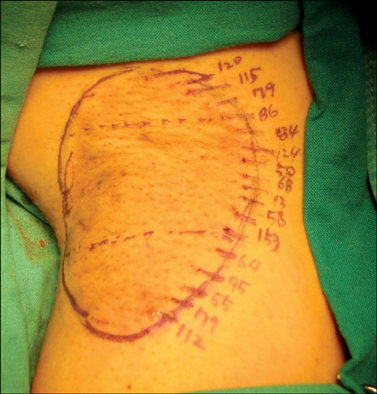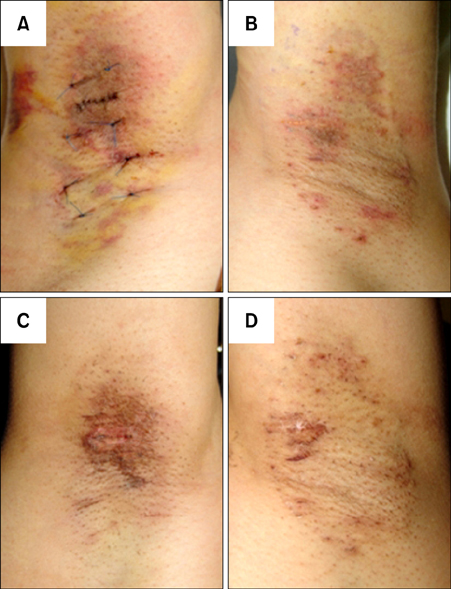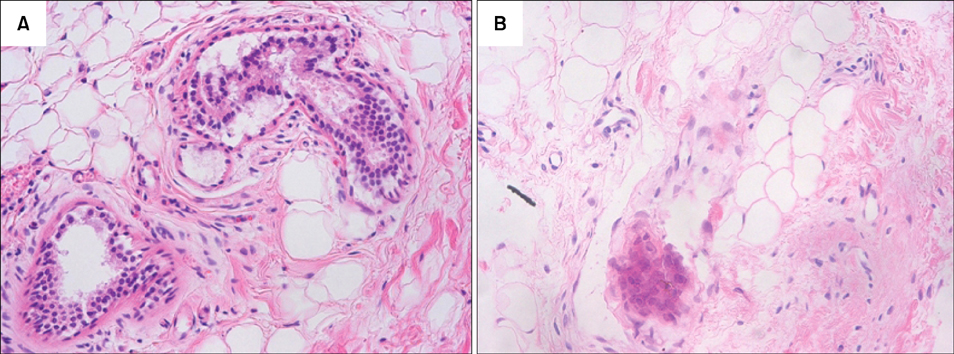Ann Dermatol.
2014 Feb;26(1):99-102. 10.5021/ad.2014.26.1.99.
Subdermal Coagulation Treatment of Axillary Bromhidrosis by 1,444 nm Nd:YAG Laser: A Comparison with Surgical Treatment
- Affiliations
-
- 1Department of Dermatology, Korea University College of Medicine, Seoul, Korea. kumcihk@korea.ac.kr
- KMID: 2265705
- DOI: http://doi.org/10.5021/ad.2014.26.1.99
Abstract
- Bromhidrosis is a disease presenting as malodor caused by interaction between the discharge of apocrine glands and bacteria. The main therapeutic modalities are applying topical agents, liposuction surgery, and elective surgery. Among these, elective surgery is reported to be most effective. However, the efficiency largely depends on surgical technique. Additionally, other side effects, such as hematoma and scarring, are occasionally reported. Currently, CO2 laser and 1,064 nm Nd:YAG laser therapy are used, but as the wavelength is not specific to apocrine glands, these laser therapies have certain limitations. Recently, a 1,444 nm wavelength Accusculpt(TM) laser (LutronicCorp., Seoul, Korea) has been developed which is now commonly used for facial fat plasty and laser liposuction therapy. The use of this laser for bromhidrosis therapy targeting apocrine sweat glands is currently being discussed. Still, no studies on practical clinical use and side effects of this 1,444 nm wavelength laser have been published. In this report, we treated one bromhidrosis patient with 1,444 nm wavelength Accusculpt(TM) laser therapy on one side while conventional surgery was performed on the other side using a modified Inaba's method. We compared the efficacy of this laser therapy to the surgical modality by measuring malodor severity and overall satisfaction by questionnaire. We also checked for other complications and recurrence for 12 months after the treatment. This patient was largely satisfied as it has a much shorter down time with the same therapeutic outcome. As subdermal coagulation treatment by 1,444 nm Nd:YAG laser may be less invasive but effective therapy, we would like to recommend this modality as a possible treatment option.
Keyword
MeSH Terms
Figure
Cited by 1 articles
-
Terminal Deoxynucleotidyl Transferase-Mediated Deoxyuridine Triphosphate Nick End Labeling (TUNEL) Assay to Characterize Histopathologic Changes Following Thermal Injury
Ji Min Lee, Ji Hyun Park, Bo Young Kim, Il-Hwan Kim
Ann Dermatol. 2018;30(1):41-46. doi: 10.5021/ad.2018.30.1.41.
Reference
-
1. Khoury JG, Saluja R, Keel D, Detwiler S, Goldman MP. Histologic evaluation of interstitial lipolysis comparing a 1064, 1320 and 2100 nm laser in an ex vivo model. Lasers Surg Med. 2008; 40:402–406.
Article2. Bechara FG, Sand M, Hoffmann K. Tumescent liposuction with dermal curettage for treatment of axillary osmidrosis and hyperhidrosis. Dermatol Surg. 2007; 33:125.
Article3. Kim IH, Seo SL, Oh CH. Minimally invasive surgery for axillary osmidrosis: combined operation with CO2 laser and subcutaneous tissue remover. Dermatol Surg. 1999; 25:875–879.
Article4. Wu WH. Ablation of apocrine glands with the use of a suction-assisted cartilage shaver for treatment of axillary osmidrosis: an analysis of 156 cases. Ann Plast Surg. 2009; 62:278–283.
Article5. Tark KC, Jung JE, Song SY. Superior lipolytic effect of the 1,444 nm Nd:YAG laser: comparison with the 1,064 nm Nd:YAG laser. Lasers Surg Med. 2009; 41:721–727.
Article
- Full Text Links
- Actions
-
Cited
- CITED
-
- Close
- Share
- Similar articles
-
- Minimally Invasive Surgery for Axillary Osmidrosis Using a Combination of Subcutaneous Tissue Removal and a 1,444-nm Nd:YAG Laser
- Clinical Outcomes and Satisfaction with Laser Treatment and Surgery of Axillary Bromhidrosis Patients: A Retrospective Analysis
- A Prospective, Long-Term Follow-Up Study of 1,444 nm Nd:YAG Laser: A New Modality for Treating Axillary Bromhidrosis
- Comparison of Wound Repair after Irradiation of Rat Skin with 1064 nm Nd:YAG, CO2, and Er:YAG Lasers
- Two Cases of Toenail Onychomycosis Treated by 1,064 nm Nd:YAG Laser




